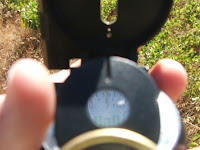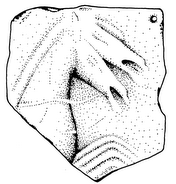Survey area organization:
The survey area is aligned on a a grid pattern. Each "square" of the grid is 100 meters by 100 meters. These squares are differentiated by a number system. Rows (traveling East-West) are given a Roman Numeral, while Columns (traveling North-South) are given an Arabic Numeral. So, for example, a particular square might be identified as "XXXII-42", meaning that it is in the 32rd row and the 42nd column. See the map below for further detail:
Each of these squares is then divided into 10 "transects". Each of these transects is 10 meters wide, since it is assumed that each individual is capable of seeing 5 meters in every direction. Unfortunately, we do not have 10 people surveying at once; we only have 7. So we are forced to use an interesting zig-zag process in order to complete 4 square segments. This process is shown in the Field Director's notebook:
The group does the best to take advantage of its numbers. We first will travel across 2 squares, covering 7 transects. We then turn back and finish the remaining 3 transects in those squares as well as 4 transects from 2 parallel squares. We then turn back yet again and complete the remaining 6 transects in those squares, along with 1 extra transect to help account for any drift.
The "Field" aspect:
The process is far from an exact science, but we have organized it as much as one can while standing waist high in grape vines and thorns. To begin with, we locate the corner of a square and mark it with flagging tape:
Once the corner has been located and marked, we choose a "leader" for the day. The leader is responsible for keeping the group aligned (either North-South or East-West, depending on which direction we're traveling). This person must always keep a compass handy, continually checking the direction that they are traveling and tracking the distance:
The responsibility does not rest solely on the leader though. Each individual in the group has their own compass and is responsible for noting a natural landmark that corresponds to the direction they are traveling and walk toward it:
The leader will stop after 20 meters (each transect is divided into 20m long sections, recognized as A-E) and realign the group:

On occassion--a very frequent occassion--we will come across some sort of obstruction in our surveying which requires us to travel around or over it. The most common are fences and gulleys (sometimes seperate, sometimes organized next to one another to increase the difficulty in crossing them).
In many cases our battles with fences cause casualties in the ranks as well:
As we travel along, we are responsible for taking notes which describe the area, the objects we
find, and any other interesting information:
Of course, after all of these things, the main goal of the survey is to actually find archaeological objects. This can however be difficult, since the ground coverage in the survey area is often thick and overgrown. Beyond this, many objects are very small. Feel free to try and find the archaeological objects in the photos below. The objects will be circled in pictures at the bottom of the post so that you can tell how accurate you were. Some are easier than others, which is also the case in the field.
After we have completed 4 full squares, we normally take a group break in the shade and rehydrate.





















